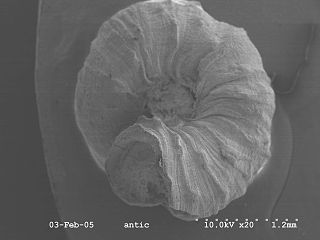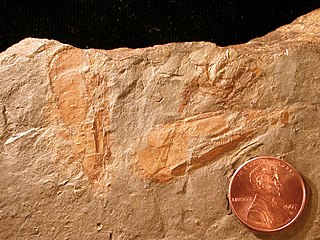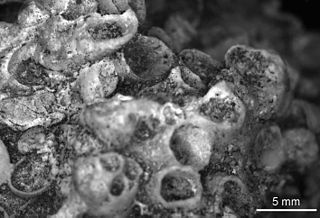 W
WAnnuliconchus is a genus of microconchid tubeworms. Their tubes have pseudopunctae penetrating the tube wall. Tubes lumen is annulated. Annuliconchus occurs in the Silurian of Baltica.
 W
WAnticalyptraea is a fossil genus of encrusting tentaculitoid tubeworms from the Silurian to Devonian of Europe and North America . Anticalyptraea commonly encrust various invertebrate fossils such as stromatoporoids, rugose corals, bryozoans, brachiopods and crinoids, but they can also be common on the hardgrounds. They were often attacked by predators in the Pridoli of Baltica.
 W
WConchicolites is a fossil genus of cornulitid tubeworms. Their shells lack vesicular wall structure and have a smooth lumen. They are externally covered with transverse ridges. Some species have spines. They usually occur as encrusters on various shelly fossils. Their fossils are known from the Late Ordovician to the Devonian.
 W
WCornulites is a genus of cornulitid tubeworms. Their shells have vesicular wall structure, and are both externally and internally annulated. They usually occur as encrusters on various shelly fossils. Their fossils are known from the Middle Ordovician to the Carboniferous.
 W
WHaplophrentis is a genus of tiny shelled hyolithid which lived in the Cambrian Period. Its shell was long and conical, with the open end protected by an operculum, from which two fleshy arms called helens protruded at the sides. These arms served to elevate the opening of the shells above the sea floor, acting like stilts.
 W
WHelicoconchus is a microconchid genus that occurs in the Lower Permian of Texas. It forms small reef-like bodies of tubes branching from a common origin. The impunctate tubes are greatly elongated for microconchids and have occasional diaphragms with central pits. The tubes branch in two ways: budding from the tube wall and binary fission. They lived in shallow, normal marine environments.
 W
WHyoliths are animals with small conical shells, known as fossils from the Palaeozoic Era. They are lophophorates, a group which includes the brachiopods.
 W
WLecthaylus is a genus of fossil sipunculid worms that lived between the Cambrian and the Lower Carboniferous periods.
 W
WMarocella is a conical shelly fossil of uncertain affinity known from Cambrian strata of Europe, Morocco, Australia and Antarctica.
 W
WOdontogriphus is a genus of soft-bodied animals known from middle Cambrian Lagerstätte. Reaching as much as 12.5 centimetres (4.9 in) in length, Odontogriphus is a flat, oval bilaterian which apparently had a single muscular foot, and a "shell" on its back that was moderately rigid but of a material unsuited to fossilization.
 W
WPalaeoconchus is a genus of microconchid tubeworms. Their tubes have pseudopunctae penetrating the tube wall. Tubes lumen is smooth. Palaeoconchus occurs in the Late Ordovician of Baltica and Avalonia. In the Devonian it had a global distribution.
 W
WPunctaconchus is a genus of microconchid tubeworms. Their tubes have large pores (punctae) penetrating the tube wall. Tubes lumen is covered by ripplemark−like transverse ridges. Punctaconchus occurs in the Middle Jurassic of England and France.
 W
WSeptalites is a genus of cornulitid tubeworms. Their shells lack vesicular wall structure and have a smooth lumen filled with numerous transverse septa. They are externally covered with transverse ridges. Their fossils are known only from the Silurian of Gotland.
 W
WSialomorpha dominicana, also known as the mold pig, is a genus of incertae sedis panarthropodan discovered in 30-million year old Dominican amber by George Poinar at Oregon State University and Diane R. Nelson at East Tennessee University. It was placed in a new genus and family (Sialomorphidae) unto itself, and appears to represent a new phylum. S. dominicana shares some resemblance to tardigrades and mites. It is about 100 µm long and grew by molting its exoskeleton. It was probably an omnivore, feeding on minute invertebrates and fungi, including mold.
 W
WWiwaxia is a genus of soft-bodied animals that were covered in carbonaceous scales and spines that protected it from predators. Wiwaxia fossils – mainly isolated scales, but sometimes complete, articulated fossils – are known from early Cambrian and middle Cambrian fossil deposits across the globe. The living animal would have measured up to 5 cm (2 inch) when fully grown, although a range of juvenile specimens are known, the smallest being 2 millimetres (0.079 in) long.